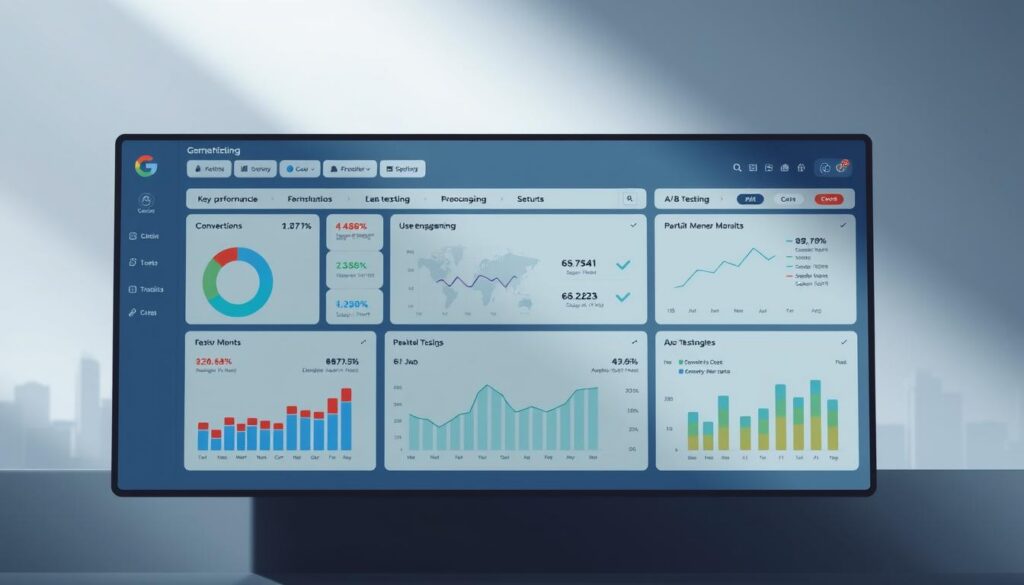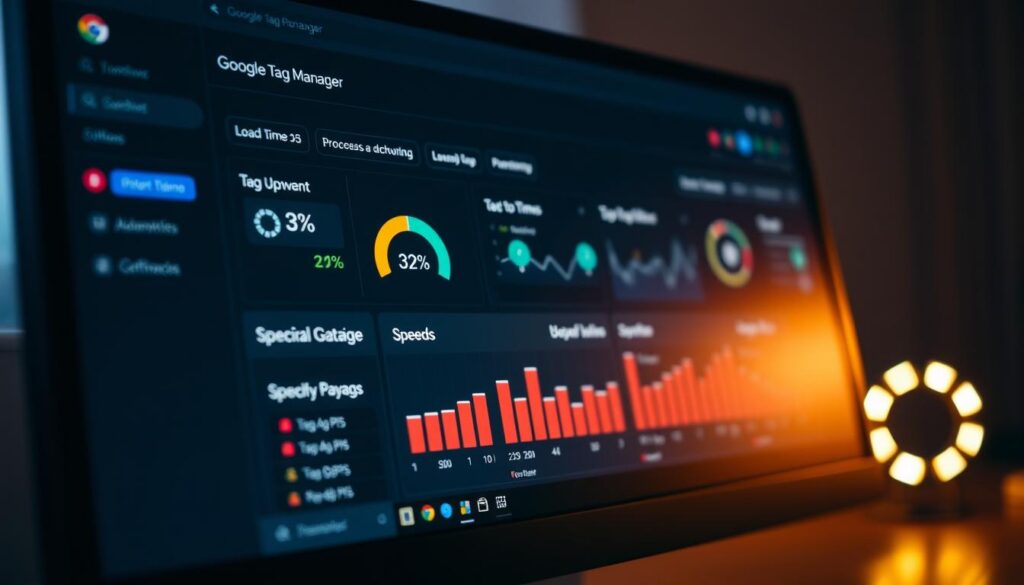In today’s digital world, knowing how to boost GTM performance is vital for businesses wanting a stronger online presence. Google Tag Manager (GTM) gives you the tools to manage marketing tags well. But, learning to make tag manager work better can really speed up your site and help with analytics. This article will explore key strategies for making GTM work more efficiently. By using these tips, your website will run smoothly and gather important data from user actions. For more on making performance better, visit this resource.
Key Takeaways
- Understanding the importance of Google Tag Manager for digital marketing.
- Implementing best practices to streamline tag usage.
- Utilizing effective metrics for measuring GTM performance.
- Exploring advanced techniques for enhanced tagging efficiency.
- Troubleshooting common issues to maintain optimal performance.
- Staying informed on future trends affecting GTM optimization.
Understanding Google Tag Manager and Its Importance
Google Tag Manager (GTM) is a handy tool for managing tracking codes on websites. It lets marketers add tags quickly without changing the code themselves. This helps marketing and development teams work together better. By using GTM, companies can follow google tag manager performance tips. These tips boost productivity and make websites run smoother.
What is Google Tag Manager?
Google Tag Manager is a powerful tool that helps businesses handle their marketing tags easily. It works with different analytics tools to make adding and managing tags simple. You don’t need to be a tech expert to use it. This makes changing your digital marketing strategy flexible and easy.
Benefits of Using GTM
GTM brings a lot of benefits to the table. It lets you put marketing tags on your site fast so you can track user actions right away. It makes teams work together better and helps with testing and version control. This means fewer mistakes when updating tags. Companies that use GTM get better at analyzing their data, which helps them make their sites more efficient.
Common Use Cases for GTM
Google Tag Manager can be used in many ways. Some common uses are:
- Adding Google Analytics for a deeper look at user behavior.
- Tracking things like form fills, clicks, and video views.
- Helping with remarketing to show ads to the right people.
Key Performance Metrics for GTM
It’s vital to watch the right metrics to tweak your Google Tag Manager (GTM) setup well. Smart gtm optimization strategies need a grasp of key metrics. These include page load times and how accurate your event tracking is. Knowing these helps judge how well you’re doing. Diving into these metrics can unlock insights on your site’s health and how users find their experience.
Identifying Relevant Metrics
Knowing which metrics matter most for your GTM is key. Important metrics are:
- New user growth rate
- Customer acquisition cost (CAC)
- Customer lifetime value (LTV)
- Monthly Recurring Revenue (MRR)
- Net Promoter Score (NPS)
With these metrics, you can make choices that boost your performance. Knowing what each metric means helps shape your google tag manager performance tips for your goals.
Tools for Measuring Performance
Choose the right tools to look closely at your data. Google Analytics, Lighthouse, and webpagetest.org are great for checking your tags’ impact. They track users and check site speed and interactions. Checking regularly lets you make sure tags aren’t slowing your site or ruining the experience. Using these tools can majorly improve your GTM game.
Analyzing Data Effectively
Analyzing your data well is crucial for spotting where things get stuck. By looking at data closely, marketers can see where GTM needs tweaking. This helps improve how fast and responsive your setup is. Regular checks help you see how tags really affect your site. Aim to make reports that show how your tags are doing and how users interact with them.

Best Practices for Tag Implementation
Effective tag management is key for Google Tag Manager’s performance. Following gtm best practices improves clarity, efficiency, and response times of setups. This part covers key strategies for smooth integration and control within GTM.
Organizing Tags for Efficiency
Keeping tags organized is vital for a clean GTM workspace. Use clear names that reflect the action tracked and the pages involved. This makes it easier for teams to work and quickly update things for better performance. Grouping tags by their purpose or target goals is a good way to achieve this organization.
Avoiding Redundant Tags
Having duplicate tags can mess up data and affect analytics. Keeping your tags unique and necessary reduces mistakes and boosts site performance. It’s wise to regularly check and remove any tags you don’t need. This practice ensures your GTM stays aligned with your current business aims.
Utilizing Triggers Wisely
Triggers help to deploy tags based on specific actions, like clicking a button or filling out a form. This boosts responsiveness. It allows for creating experiences that match how users interact with your site. To learn more about setting up triggers effectively, check out the best practices guide for GTM.
Advanced Techniques for Enhanced Performance
Exploring advanced techniques allows for significant improvements in GTM efficiency. These strategies not only enhance gtm speed but also optimize tag manager performance in ways that can dramatically affect website usability and analytics. Implementing a combination of innovative methods creates a streamlined tagging environment.
Server-Side Tagging Strategies
Server-side tagging shifts the execution of tags from the browser to the server. This technique reduces the load on users’ browsers and minimizes the time necessary to load pages. Moreover, by controlling data collection and processing on the server side, businesses can enhance gtm speed and accuracy in analytics, ensuring a cleaner and more effective user experience.
Lazy Loading Tags for Faster Page Loads
Implementing lazy loading for non-essential tags helps improve overall performance. This strategy allows tags to load only after the crucial content has been rendered. As a result, visitors interact with the primary features of a website without delay, while secondary tags load in the background. This method optimizes tag manager performance and provides a smoother experience for users, leading to better engagement and faster page loads.
Optimizing Third-Party Tag Performance
Third-party tags can often hinder performance if not managed carefully. Streamlining these tags involves ensuring they do not interfere with critical content rendering. Techniques include asynchronous loading and prioritizing essential tags to be executed first. Such optimizations can significantly enhance gtm speed and reduce the overall load time for web pages, providing a balance between functionality and speed.

| Technique | Description | Benefits |
|---|---|---|
| Server-Side Tagging | Executes tags on a server instead of the user’s browser. | Reduces load times and increases data accuracy. |
| Lazy Loading | Defers loading of non-critical tags until after important content is shown. | Improves initial load speed and user experience. |
| Third-Party Tag Optimization | Ensures minimal interference from third-party scripts. | Enhances page performance without sacrificing functionality. |
Troubleshooting Common GTM Issues
Getting Google Tag Manager to work right involves fixing common problems. By tackling these issues, marketers can make their tracking better and get more from their analytics. This part talks about usual troubles and solutions that follow GTM best practices to improve GTM efficiency.
Identifying Tag Firing Errors
Errors in tag firing can mess up your data. It’s important to frequently check if all tags are working as they should. Using GTM’s preview and debug modes makes spotting mistakes easy. Mainly, you’ll see tags that don’t fire because of wrong conditions or conflicts.
Resolving Debugging Conflicts
Conflicts happen when many tags try to fire at once. Knowing the order tags should fire in is crucial. Marketers need to use GTM’s debug tools to find and fix these issues. By testing tags one by one, they can find and solve code conflicts. This makes GTM work smoother by following best practices.
Ensuring Accurate Conversion Tracking
Tracking conversions right is key to knowing if campaigns are working. Check conversions often and use GTM’s tools to keep data accurate. Look closely at how you’re tracking to make sure it matches your goals. Doing this improves GTM efficacy and leads to more trustworthy analytics data.
Future Trends in GTM Performance Optimization
The digital marketing world is always changing, making it important to stay updated on future GTM trends. New technologies, like AI-driven analytics, bring new ways to use Google Tag Manager to its fullest. By diving into more complex data layer functions, companies can make their tracking more powerful and work more smoothly.
Emerging Technologies Impacting GTM
Real-time data is becoming more essential for organizations, and machine learning in GTM is a growing trend. These tools help fine-tune marketing strategies and increase user interest. They let marketers predict what users will do next, making it easier to meet consumer needs.
Anticipating Changes in Privacy Regulations
Staying up-to-date with privacy laws is also vital for tracking data safely. Being compliant keeps customer trust and extends the life of marketing strategies. Getting to know new laws, like those in this resource, helps teams adjust their plans when needed.
Preparing for Evolving Analytics Needs
The need for better analytics is growing. Companies must adjust their GTM approaches to fit these needs. Being flexible and willing to try new things is key to keeping up. Adapting to these trends is how businesses will succeed with GTM.
FAQ
What is Google Tag Manager?
Google Tag Manager, or GTM, makes it easier to handle website tags and collect data. It lets marketers add or change tags without coding.
What are the benefits of using GTM?
Using GTM helps marketing and development teams work better together. It allows for fast tag deployment and better tracking through other tools.
What are common use cases for GTM?
GTM is often used for adding Google Analytics, tracking how users interact, and making remarketing easier.
Which performance metrics should I track for GTM?
You should watch how fast pages load, how accurately events are tracked, and how users interact. These metrics show how well GTM and your website are doing.
What tools can be used to measure GTM’s performance?
Google Analytics, Lighthouse, and webpagetest.org can help you see how GTM is working.
How can I organize tags for better performance?
For better performance, name tags clearly, keep the GTM interface clean, and remove tags you don’t need. This helps your site load faster.
What are the best practices for implementing tags in GTM?
Don’t use too many tags. Make sure they only activate when needed, and check your tag setup often to keep it working well.
What is server-side tagging, and how can it improve GTM performance?
Server-side tagging handles tags on the server, not on the user’s browser. This makes pages load faster and improves your website’s performance.
How does lazy loading benefit GTM performance?
Lazy loading waits to load some tags until the main content is shown. This speeds up how fast your site loads for users.
What common issues should I watch for when using GTM?
Watch out for issues like tags not firing correctly, tags conflicting, and inaccurate tracking of conversions. These can mess up your data.
How can I ensure accurate conversion tracking?
Test your tags often and use GTM’s debugging tools. This helps keep your tracking accurate and fixes errors quickly.
What emerging technologies should I be aware of for GTM optimization?
Keep an eye on new tech like AI for analytics and better data layers. These will change how you use GTM for better results.
How can I prepare for evolving analytics needs and privacy regulations?
Stay up to date on privacy trends and follow new laws. This will keep users’ trust and ensure your GTM use remains top-notch.



